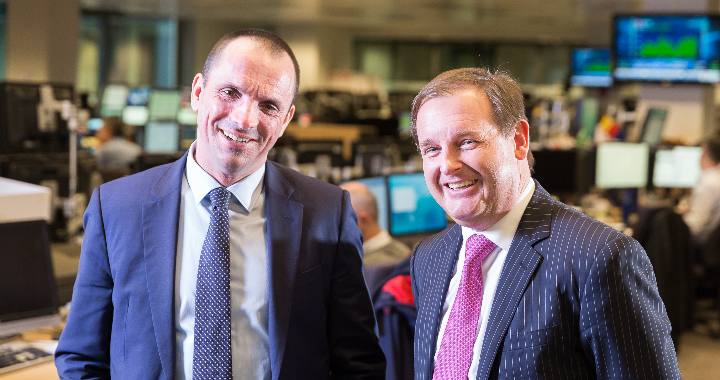Will the recovery be different this time?
With the arrival of summer and vaccines, everyone is looking forward to the forthcoming economic recovery. And it’s looks increasingly rosy, not least because of the successive recovery plans in the United States. There, we expect economic growth of almost 7% this year and 4.7% in 2022. Europe is also benefiting. The vaccination campaign is well under way in most European countries. An additional positive boost comes from the NextGenerationEU plan that has now been approved by almost all Member States. The slow start means that for this year we ‘only’ forecast growth of 4.2%, but next year this should be 5%. Belgium follows in its wake with growth of 4.8% and 3.0% respectively.
Koen De Leus, Chief Economist: “After previous recessions, the economy usually neither recovered to the pre-recession growth path nor reached the growth rate before the contraction. The greater the scars, the greater the permanent damage. But despite the hardest crisis since the Great Depression, this time it might be different. Early next year, the United States will already return to their pre-recession growth path. The question is whether this growth will surpass pre-crisis growth and whether other countries will follow.”
Limited scars
The speed of recovery after an accident is closely linked to the severity of the injuries sustained. It’s really not different after recessions. We can identify five possible injuries: higher debts, increased bankruptcies, unemployment and zombie companies, and less investment.
Global debts may be at their highest level ever, but on the positive side, the debt-to-GDP ratio of households and financial institutions has increased only slightly. Corporate debt rose sharply but this tends to leave fewer scars, as previous crises have shown.
Massive government interventions have also diminished the number of corporate failures and unemployment, especially in Europe. In the United States, the number of company failures and the unemployment rate are slightly higher.
But by allowing more companies to go under, the United States is preventing a marked increase in zombie companies, the fourth type of scar. Zombie companies weigh on the long-term productivity of an economy. Zombie or bankruptcy? It is a tough trade-off for politicians.
In the end, business investment was lower during the crisis. But there too, we have recently seen a positive turnaround in the countries where recovery has been in full swing.
Back to the roaring twenties?
With the NextGenerationEU plan and the even bigger but still to be approved Build Back Better plan in the United States, government leaders are well on their way to avoiding the mistakes of post-2008. Certainly in Europe, the switch from stimuli to savings was made too quickly.
What recovery lies ahead? Optimists like to refer to the roaring twenties and the period after the Second World War. However, we are not repeating the population explosion of those post-war periods, on the contrary. And with the current high level of debt, a spectacular rise in credit like then is not likely in the coming years either. On the other hand, the current exceptionally low interest rates are no obstacle to budget deficits and rising government debt. The important question: how long will the marriage of convenience between monetary and fiscal policy last?
Another joker is productivity. Can we think about reversing the slowing productivity trend of the past four to five decades? According to consultant McKinsey, we have in just one year taken a step forward that equates to 3 to 7 years when it comes to digitising customer interactions and offering digital goods and products.
Artificial intelligence, big data, but also the circular economy and sustainable energy sources are part of Industry 4.0. Crucial to accelerating productivity is that these ‘General Purpose Technologies’ are integrated into a fully adapted production process and picked up by as many companies as possible.
De Leus: “If we get it right, we may have a reset of the economy rather than simply a restart. After the two world wars, the infrastructure had to be rebuilt. Today, it must be thoroughly adapted to meet climate challenge. This requires major public investments and adjustments to business production. If we make a virtue of necessity, this rediscovered dynamism may, unlike most previous recoveries after crises, lead to higher rather than lower growth. This time, it really could be different.”
The markets: inflation and interest rates
After a strong 2020, and despite the pandemic, the global equity markets have had another bullish first five months. The increase is mainly driven by the strong economic recovery and the related spectacular rise in corporate profits. The past two months have been rather flat as the positive catalysts are being countered by sharply rising inflation and fears that this may prompt central banks to reduce their support purchases in the bond markets and eventually raise interest rates.
Is the surge in inflation driven by problems in supply chains and base effects? If so, it would be transitory, as the central bankers would have us believe. Or is it a structural rise in inflation?
Philippe Gijsels, Chief Strategy Officer: “The heart of our strategy is still that inflation will continue to rise slightly to moderately and that central banks and governments will do everything they can to keep interest rates low. In other words, we will live in a world of low or even negative real interest rates for quite some time. This is an environment in which cash is very unattractive because it is devaluing at a very fast rate. From an investment point of view, this means we are still betting on real assets such as equities, real estate, precious metals, commodities and art.”
Focus on value stocks
The first five months of the year were also characterised by a strong sector rotation, from growth to value stocks that are often also cyclical in nature. Last year, during the lockdowns, it was mainly growth stocks, technology stocks or stay-at-home stocks that did particularly well. They were the companies that were able to show strong revenue growth and strong earnings growth in a world where many others were losing out. That made their prices soar.
This year, especially since the news that the vaccines were coming, the market started to bet more and more on the “opening up” stocks, stocks that benefit from the reopening of the economy and the cyclical recovery. So the cyclical and value stocks. What did tremendously well last year is now being sold off to buy the laggards and losers of last year and the years before that. This is usually described as the reflation trade. As inflation rises, and with it the fear of interest rates, technology stocks do less well because they have much of their profits in the future, and so are more penalised if we have to discount those profits or free cash flow today.
We’re sticking to our long-standing barbell strategy of combining growth and value stocks. The latter group will continue to benefit most from an economic rebound. But we also believe that neglecting growth stocks and not including them in portfolios is not a good idea. For these are and will remain the companies and technologies of the future. And if we consider that the pandemic has brought us technological progress in many areas at a rate 3 to 5 times higher than normal, we expect many great things to come. Moreover, history teaches us that the outperformance of value stocks usually diminishes when economic indicators, especially leading indicators, peak. And we could be relatively close to that.
Although in the longer term we remain positive on real assets and therefore also for equities, in the short-term equity markets are somewhat overbought. Moreover, we also see signs of euphoria and speculation here and there. The summer months could be a little more difficult and we see increased volatility. It is therefore not a bad idea to build some safety into the portfolios.
Commodities
Gijsels: “Closely related to the strong performance of cyclicals and value stocks is the strong bull market in commodities. We believe we are only at the beginning of a supercycle here that is being driven by both demand and supply elements.”
On the demand side, there is the recovery of the global economy, strong demand from China and the electric revolution whose impact is still underestimated. On the supply side, there is the underinvestment in new capacity of the past few years. As a result, many metals will soon go into deficit (whereby demand exceeds supply), which could push prices even higher.
The mining sector is also increasingly choosing to work more energy-efficiently and is paying more attention to the environment through the use of new technologies. This means therefore that a super cycle in commodities and SRI (Socially Responsible Investing) are no longer contradictory.
In the slightly shorter term, we may see the commodity business, like equity markets, consolidate somewhat. The electric revolution is a longer-term story. But in the shorter term, demand from China will be decisive. China has had a spectacular first quarter with 18% year-on-year growth. Usually we see the Chinese government trying to cool the economy down a bit out of fear of overheating. We can already see this in the credit impulse. Normally, with a few months delay, we then see the commodity business also come under some pressure. But this downturn will be no more than a blip on the charts of a spectacular bull market within a few years.
Fragmentation of the growth markets
We remain positive for the growth markets. The global economy is picking up and commodity prices are rising - this is particularly good for many of Latin America’s commodity producers - and the dollar is relatively weak.
On the other hand, we have to be more selective and cannot really speak of the emerging market complex as a whole any more. There is strong fragmentation taking place; some emerging countries have the wind in their sails while others are struggling with economic and geopolitical problems. Many of them are also unable to stimulate their economies monetarily and fiscally as Western countries do, because their currencies will immediately come under pressure. Some others are lagging behind. So it is a matter of being selective. And that actually applies to all markets and asset classes at the moment.
Note 1: this text was made on 1 June 2021.
Note 2: the sources used can be found in the accompanying slideshow published at https://www.bnpparibasfortis.com/nl/newsroom.
Koen De Leus - Will the recovery be different this time?
Philippe Gijsels - Financial markets
Full Press Conference 09/06/2021
BNP Paribas Fortis (www.bnpparibasfortis.com) offers the Belgian market a comprehensive range of financial services for private individuals, the self-employed, professionals, companies and public organisations. In the insurance sector, BNP Paribas Fortis works closely, as a tied agent, with Belgian market leader AG Insurance. At international level, the Bank also provides high-net-worth individuals, large corporations and public and financial institutions with customised solutions, for which it is able to draw on the know-how and international network of the BNP Paribas Group.
BNP Paribas (www.bnpparibas.com) is a leading bank in Europe with an international reach. It operates in 68 countries and has more than 193,000 employees, including nearly 148,000 in Europe. The Group has key positions in its three main activities: Domestic Markets and International Financial Services (whose retail-banking networks and financial services are covered by Retail Banking & Services) and Corporate & Institutional Banking, which serves two client franchises: corporate clients and institutional investors. The Group helps all its clients (individuals, community associations, entrepreneurs, SMEs, corporates and institutional clients) to realise their projects through solutions spanning financing, investment, savings and protection insurance. In Europe, the Group has four domestic markets (Belgium, France, Italy and Luxembourg) and BNP Paribas Personal Finance is the European leader in consumer lending. BNP Paribas is rolling out its integrated retail-banking model in Mediterranean countries, in Turkey, in Eastern Europe and a large network in the western part of the United States. In its Corporate & Institutional Banking and International Financial Services activities, BNP Paribas also enjoys top positions in Europe, a strong presence in the Americas as well as a solid and fast-growing business in Asia-Pacific.


